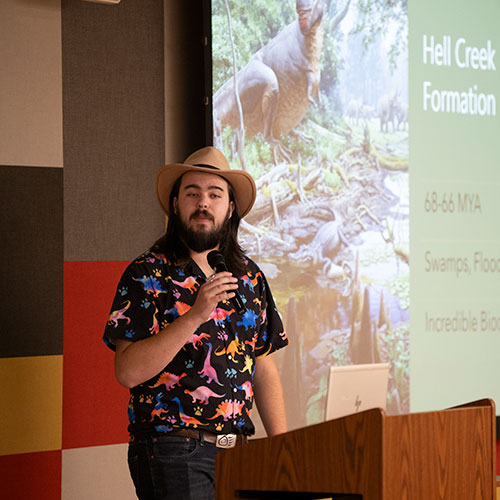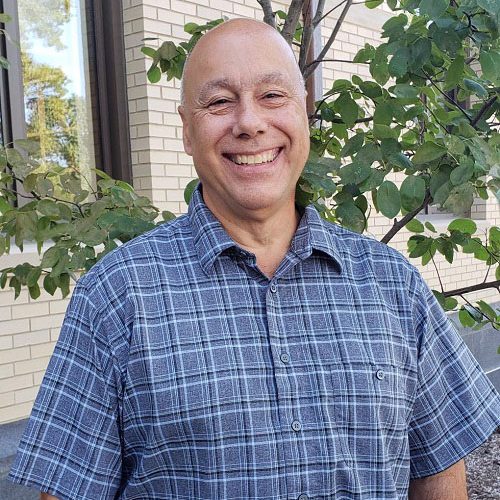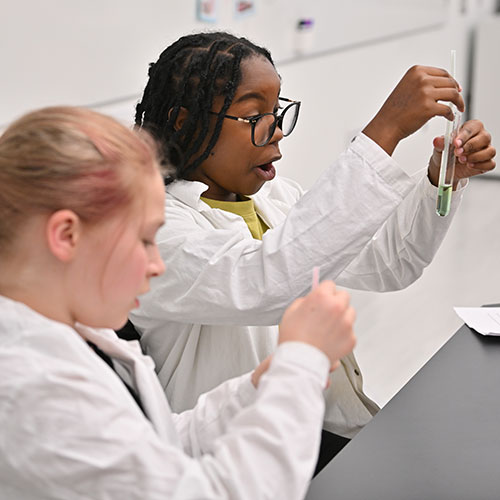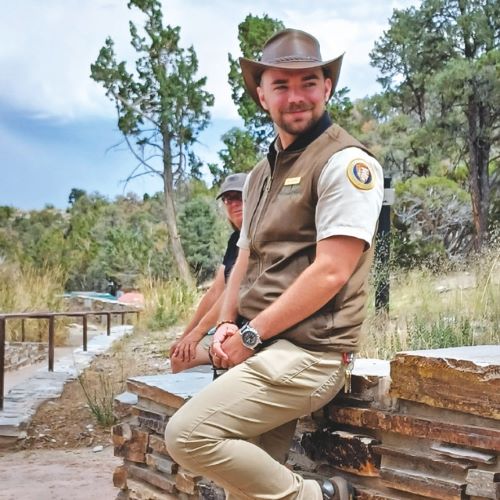
Wooster geology major excavates new insights from dinosaur teeth
For 120 years, researchers have studied dinosaur skeletons in the Hell Creek Formation, an iconic Late Cretaceous formation that spans throughout Montana, Wyoming, and […]
Geology graduates from Wooster go on to be geoscientists specializing in natural hazards, non-renewable and renewable energy, and water resources. They work for natural resource companies, consulting firms, and government agencies with job titles ranging from project manager and lab director to engineer and data analyst. Some go on to careers in science education in schools, national parks, museums, and non-profit organizations. Others pursue careers in communication as journalists, illustrators, and editors for media outlets, such as National Geographic. Many of our graduates make their way to top-tier graduate or professional programs to build careers in research, law, and more. Wooster ranks sixth among U.S. institutions where women doctorate recipients in the physical sciences earn bachelor’s degrees according to a 2019 report published by the Council of Independent Colleges based on data from the National Center for Education Statistics and National Science Foundation.
Geology majors focus on the physical planet and the interactions of Earth’s spheres over ‘deep’ time. The Earth is our classroom and our small, advanced classes feature field trips to world-class exposures of glaciated terrain and fossils. As early as their first year, students start conducting research in our state-of-the-art science and computing labs. Experiential learning is central to our program and many of our students participate in summer internships and research projects arranged by the college. All students at The College of Wooster complete independent study under the guidance of a faculty mentor. The research work culminates in a thesis delivered in the spring of senior year.
View 2022 Annual Report (PDF)Learn about Wooster’s STEM community through the STEM Success Initiative
Learn about Wooster’s STEM community through the STEM Success Initiative
Instrument and Lab Tech/Machinist - Biology, Chemistry, Earth Sciences, Physics

For 120 years, researchers have studied dinosaur skeletons in the Hell Creek Formation, an iconic Late Cretaceous formation that spans throughout Montana, Wyoming, and […]


The B-WISER educational summer camp, a partnership between The College of Wooster and the Martha Holden Jennings Foundation, will take place June 10-15, 2024. […]


Major: Geology Class Year: 2024 Organization: Burpee Museum of Natural History I will join the Burpee Museum of Natural History as a field assistant, working […]



Ryan Johnston ’23 says he’d be a very different person if he hadn’t attended The College of Wooster. The Ohio native came to play […]
The Earth Sciences Department offers two majors: geology and environmental geoscience. Both majors share a set of foundational science courses, followed by a selection of advanced courses in the Earth sciences or cross-listed disciplines that allow students to pursue their interests and goals. The geology major is a more traditional Earth science curriculum that prepares students for a variety of geoscience careers in fields ranging from paleontology and natural disasters to energy and natural resources.
View Courses
Students who want to build on their course of study with a minor that includes geology can opt to add a minor in Earth Sciences, which requires completion of six courses in geology and environmental geoscience.
View Courses
In their junior year, Geology and Environmental Geoscience majors undertake a Junior Independent Study (I.S.) project in close collaboration with their peers and a faculty mentor. Students study the concepts and techniques of Earth Science research to prepare for their senior I.S., a capstone experience that challenges them to design and pursue a research project that makes an original intellectual contribution to the geosciences. Because Earth Sciences are best learned by doing, majors often participate in extended field/lab work or a research program during the summer between their junior and senior years. In recent years, students have undertaken field studies in diverse places in the U.S. (Alaska, California, Indiana, Kentucky, Massachusetts, Minnesota, Oregon, Pennsylvania, Utah, Vermont, Washington) and across the globe (Bahamas, Belize, British Columbia, Cyprus, Mongolia, Iceland, Israel, and western Europe). Our students have worked alongside researchers in labs at The Ohio State University, UNC Chapel Hill, UMass Amherst, and the American Museum of Natural History, among other institutions.
| Student | Year | I.S. Title | Major 1 | Major 2 | Advisor |
|---|---|---|---|---|---|
| Please search to view results | |||||
For 120 years, researchers have studied dinosaur skeletons in the Hell Creek Formation, an iconic Late Cretaceous formation that spans throughout Montana, Wyoming, and […]
Ryan Johnston ’23 says he’d be a very different person if he hadn’t attended The College of Wooster. The Ohio native came to play […]
Name: Lauren Kreeger Major: Geology Minor: German Studies Advisor: Dr. Shelley Judge, Dr. Mark Wilson The degassing of bubbly silicic melts controls the explosivity […]
Name: Judith Topham Major: Geology Advisors: Meagen Pollock, Mark Wilson Bræðravirki is a hyaloclastic dominated tindar in the Western Volcanic Zone of Iceland. It is […]
Geology graduates from Wooster go on to be geoscientists specializing in natural hazards, non-renewable and renewable energy, and water resources. They work for natural resource companies, consulting firms, and government agencies with job titles ranging from project manager and lab director to engineer and data analyst. Some go on to careers in science education in schools, national parks, museums, and non-profit organizations. Others pursue careers in communication as journalists, illustrators, and editors for media outlets, such as National Geographic. Many of our graduates make their way to top-tier graduate or professional programs to build careers in research, law, and more.
This story originally appeared in the Spring 2023 edition of Wooster Magazine. Lauren Vargo ’13 came to The College of Wooster because she wanted […]
Following the 150-year anniversary of the California Geological Survey (CGS), Trinda Bedrossian ’69, a geology major at The College of Wooster, felt inspired to […]
The research opportunities at Wooster prepared Sarah McGrath ’17 for her graduate studies
As a geologist for the United States Geological Survey, Kelli Baxstrom ’16 put much of the expertise learned from her time at The College […]
The Richard G. Osgood, Jr., Memorial Lectureship in Geology was endowed in 1981 by his three sons in memory of their father. Dr. Osgood was a paleontologist with an international reputation who taught at Wooster from 1967 until 1981. Funds from this endowment are used to bring a well-known scientist interested in paleontology and/or stratigraphy to the campus each year to lecture and meet with students.
The Department of Earth Sciences is housed in Scovel Hall, one of Wooster’s most attractive buildings. Equipment available to earth sciences majors includes binocular and petrographic microscopes, a video system attached to a microscope, computers, photomicroscopes, zoom transfer stereoscope, fluid inclusion system, variable magnification scanning stereoscope, diamond saws and and rock grinding equipment, photography labs, thin-section machine, mapping projector, seismic station, and large sedimentological, paleontological and mineralogical collections. The earth sciences library holdings are unusually complete for a small college.
The paleontological facilities at Wooster include standard rock saws and grinders, along with Nikon microscopes, digital imaging systems, and fossil preparation tools. We also have extensive research collections, particularly for carbonate hardgrounds, ancient bioerosion, Ordovician invertebrates, and Jurassic limestones and fossils.
Ohio is a wonderful place to pursue undergraduate research in sedimentology and stratigraphy through Wooster’s Independent Study program. The local rocks provide an excellent sample of Paleozoic paleoenvironments and rock types. Our equipment includes GPS devices, computers, digital imaging equipment, numerous Nikon petrographic and dissecting microscopes, and the standard rock preparation tools, such as saws, grinders, and thin-section machines.
Dendrochronology or tree-ring dating is the method of scientific dating based on the analysis of tree-ring growth patterns. The tree-rings extracted from old wood can be calendar-dated and thus we can determine the calendar date the tree was cut. The tree-ring series are also records of past drought. We are interested in sampling historical structures for their tree-ring records. Our goal is to assemble long tree-ring chronologies from oaks by sampling both living trees and old wood. The data will be used by us and others in modeling past droughts in Ohio and together with similar records across North America.
The acquisition of an X-ray Fluorescence Spectrometer (XRF) and an X-ray Diffractometer (XRD) was funded by the National Science Foundation to support Wooster’s robust undergraduate research program. In addition to providing our students with valuable hands-on analytical experience, we hope that the instruments will foster creative collaborations and interdisciplinary research. Please explore this site to learn more about the instruments, who we are, and the research possibilities.